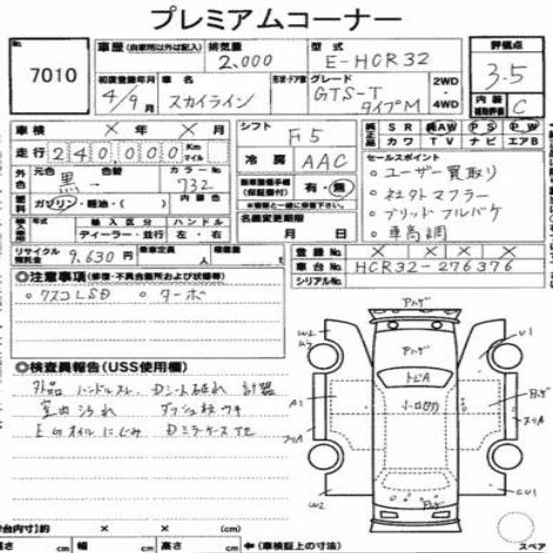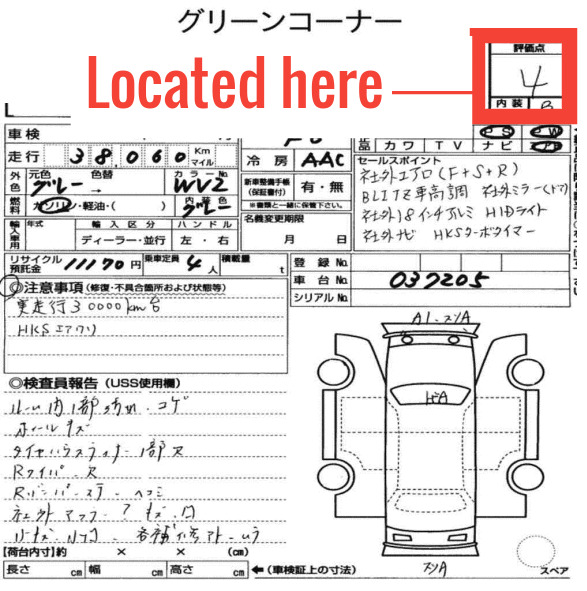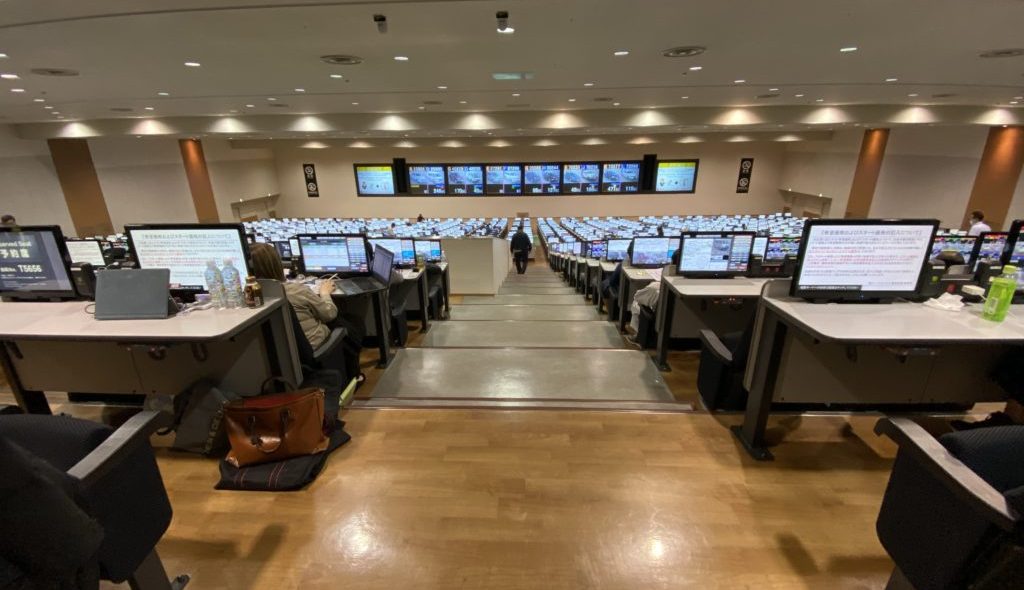Auction information
Gaining a comprehensive understanding of the Japanese auction system is crucial to importing your desired vehicle. This page serves as a guide to educate you and address any concerns you may have. If you have any additional inquiries, please don’t hesitate to contact us for further assistance.
5.0
5.0
1 Review
5.0
7 reviews
How to read a JDM car auction Sheet
Auction Sheets are a crucial aspect of purchasing a vehicle in Japan, providing critical information about the condition of the car. At Jurojin Imports, we make it easier for our customers by providing English translations of the Auction Sheet for all Japanese vehicles.
Developing expertise with Auction Sheets requires practice, which is why we highly encourage our customers to visit our website regularly to refine their skills and become experts in no time.
This is a typical auction sheet:

This is our translation:
1992 NISSAN SKYLINE GTS-T TYPE M 2000cc.
Grade 3.5, Interior C, 240,000 km, 5sp – AC – AW – PS – PW.
Original black, Sales points, Purchased from user, Aftermarket exhaust, Blitz full bucket seat, Adjustable suspension, Notes, Cusco LSD, Turbo, Report. Aftermarket steering wheel wear, Driver seat ripped, Aftermarket gauges, Interior dirty, Dashboard comes up, Engine oil leak, Door mirror case faded.
Diagram notes, Front bumper, hood, trunk, right side paint peelingWindshield rock chip, Roof dents (many), Left and right side skirt scuffed, Left front fender W2 uneven.
What are auction grades
Every vehicle available at Japanese auctions comes with an “Auction Grade” rating, reflecting its overall condition. The grades, along with their meanings, are listed to the right (or below on mobile).
These grades can be a useful tool to guide your search and help you find a vehicle that meets your desired condition. However, it’s important to note that the grades can vary between different auctions and inspectors, so never place a bid without a full translation and, ideally, a pre-bid inspection.
Remember, even cars with high grades like 4.5 can have significant issues despite appearing to be in excellent condition.

Auction grade 5
A grade 5 car is considered excellent or near-perfect and is highly sought after. It’s uncommon to find a car that has received this rating and is older than 10 years.
Auction grade 4.5
The 4.5 grade car is an outstanding option considering its age. It is expected to have minimal flaws, and any existing ones are likely to be minor and simple to repair. It is uncommon to come across a 4.5 graded vehicle older than 15 years.
Auction grade 4
Grade 4 vehicles are in exceptional condition for their age, showcasing minimal signs of wear and tear. Some light fading of paint may be present, along with small to medium sized dents, and a mileage reading of 100,000 km or less.
Auction grade 3.5
The most commonly encountered grade is 3.5, which often corresponds to cars in decent condition. However, it’s crucial to thoroughly review the condition notes, as the vehicles may exhibit signs of wear and tear such as cigarette burns, substantial dents, chipped paint, and substantial scratches. Typically, mileage ranges from 100,000 to 200,000 kilometers.
Auction grade 3
Grade 3 is typically used to describe a vehicle that is in poor condition, either due to wear and tear, rust, or mechanical issues. It may also refer to a vehicle that has been involved in a minor accident, but hasn’t undergone any frame repairs to meet the requirements for an “R Grade” classification.
Auction grade 2
Grade 2 vehicles are typically in extremely poor condition and are not ideal for driving. They often have significant rust damage on crucial parts such as floorboards, body panels, and frame sections. It is generally not recommended for inexperienced buyers to purchase these cars, as they are best suited for use as parts only.
Auction grade R
These vehicles have undergone repair following an accident. They are not considered salvage or written off cars, the extent of the damage may vary. Some R-grade vehicles are in excellent condition, while others may have lingering issues. The auction sheet provides a detailed description of any repaired or damaged areas, allowing customers to make an informed decision about which cars meet their standards.
Auction grade ***
Triple star or “0” rated vehicles have not undergone any inspection and are considered ungraded. These cars often have not been repaired following accidents or have other significant issues, and as a result, they may not be operational.
What are Interior auction grades
The classification of a car’s interior and exterior is straightforward, represented by a letter grade. However, this alone does not provide enough insight to determine the car’s bidding worthiness. To make an informed decision, it is crucial to review the report and diagram sections of the car’s profile. While working with us eliminates the need for manual checking of auction sheets, it is always wise to conduct a personal evaluation as a double check.

Auction grade - A
A grade of “A” indicates that the car’s interior is in excellent condition, which is uncommon for vehicles older than a decade unless they have been meticulously maintained.
Auction grade - B
The B interior presents well. Although the interior of the vehicle may require cleaning, or show signs of wear on the steering wheel and shift knob, it is unlikely to have any significant issues requiring repairs.
Auction grade - C
Many vehicles that are 15 years or older are classified as Grade C. This classification can vary greatly between different auctions. Some view Grade C as the lowest classification, while others consider it to be of moderate quality. The condition of a Grade C vehicle can range from excellent to poor, so it is important to review the report section to assess any damages.
Auction grade - D&E
Cars classified as D and E in auctions are typically in poor condition, with common issues such as cracked dashboards, sagging headliners, torn seats, stained interiors, and missing parts of the interior.
JDM imports frequently asked questions. FAQ.
You probably still have many questions but Don't worry, it takes time to get the hang of this. Feel free to contact us with any questions you have, and in the meantime, have a look at these commonly asked questions.
Press/Click question to show the answer
The simple answer is yes. Several cars that go through auction will have unknown mileage though. This will always be mentioned on the auction sheet. Check on the auction sheet beside the mileage for these marks – *, #, $. Our translation will always clearly state it as well.
The seller writes half of the sheet and the auction inspector writes the other half. The seller writes the car info, sales points, and notes. The inspector writes the condition report and diagram notes. The inspector also checks the info written by the seller to make sure it’s correct.
yes you can, The auction is a third party. That means they are not affiliated with the seller. In fact, the auction gets paid whether the car sells or not. There are over 100 auctions across Japan. They are in competition with one another. If the inspections were not trust worthy at that auction, buyers would stop buying from them.
It happens from time to time when the inspector misses something on the auction report. If this happens, we can claim to the auction. Providing the auction allows for the claim, we can either be awarded a monetary refund, or the option to return the vehicle. Note that cars over 10 years old usually don’t qualify for claims on the condition of the vehicle, or the vehicle’s mechanical condition.
We will translate the sheets for you. This includes the sales points, notes, report, and the Japanese on the diagram notes. Note that Jurojin imports does full translations of the auction sheets. Most exporters only partially translate the sheets and some don’t at all.
Different auctions have slight differences in there sheets, but for the most part, this is not necessary to pay attention to in order to buy a car. The same basic formula is shared between all the major auctions.
You can buy any grade car that you like. Some people want pristine cars, some want project cars, and there are customers everywhere in between. What I have seen however is that most people buying lower grade cars end up not being completely satisfied. Unless you are an expert in building cars, it’s easy to fall into the trap of not realizing how much is involved in bringing life back into a car.
Be careful looking at the pictures of the car. The true vehicle condition is not accurately shown in the pictures. Get in the habit of reviewing the auction sheet body diagram in detail instead of looking at the pictures to gauge the quality of the vehicle. Auction sheets always describe even the smallest flaws and issues in detail, so its best to cross examine using both.

